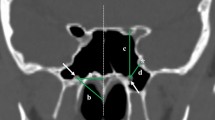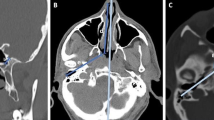Abstract
Persisting embryonal infundibular recess (PEIR) is a very rare anomaly of the floor of the third ventricle in which the embryonic morphology of the infundibular recess (IR) persists. The exact underlying mechanism of development of PEIR is unknown, and the anomaly has been reported as an isolated finding or in association with other conditions. On the other hand, trans-sphenoidal encephaloceles are the rarest form of basal encephaloceles. The trans-sphenoidal trans-sellar encephalocele (TSE) is the least common variant in which the pituitary gland, pituitary stalk, optic pathways, parts of the third ventricle and IR may be present within the encephalocele. We recently treated one patient with TSE. Based on the observed morphological similarity of the IR in our patient and in the published cases of PEIR, we reviewed the literature in order to validate the hypothesis that PEIR and TSE may possibly belong to one spectrum of malformations. Across the published reports, the morphology of the IR in TSE is very closely similar to PEIR. Moreover, radiological, patho-anatomical, and embryological evidence is in support to our hypothesis that PEIR and TSE are most likely the two extremes of the same continuum of malformations.



Similar content being viewed by others
References
Siow TY, Chuang CC, Toh CH, Castillo M (2018) Persisting embryonal infundibular recess: case report and imaging findings. World Neurosurg 117:11–14. https://doi.org/10.1016/j.wneu.2018.05.228
Belotti F, Lupi I, Cosottini M, Ambrosi C, Gasparotti R, Bogazzi F, Fontanella MM, Doglietto F (2018) Persisting embryonal infundibular recess (PEIR): two case reports and systematic literature review. J Clin Endocrinol Metab 103(7):2424–2429. https://doi.org/10.1210/jc.2018-00437 (PMID: 29788483)
Kuroiwa M, Kusano Y, Ogiwara T, Tanaka Y, Takemae T, Hongo K (2014) A case of presumably Rathke's cleft cyst associated with postoperative cerebrospinal fluid leakage through persisting embryonal infundibular recess. Neurol Med Chir (Tokyo) 54(7):578–81. https://doi.org/10.2176/nmc.cr2013-0014. Epub 2013 Dec 5. PMID: 24305020; PMCID: PMC4533456
Šteňo A, Popp AJ, Wolfsberger S, Belan V, Šteňo J (2009) Persisting embryonal infundibular recess. J Neurosurg 110(2):359–362. https://doi.org/10.3171/2008.7.JNS08287
Kühne D, Schwartz RB (1975) Persisting intrapituitary recessus infundibuli. Neuroradiology 10(3):177–178. https://doi.org/10.1007/BF00341823
Schumacher M, Gilsbach J (1979) A new variety of “empty sella” with cystic intrasellar dilatation of the recessus infundibuli. Br J Radiol 52:862–864. https://doi.org/10.1259/0007-1285-52-623-862
Vallee B, Besson G, Person H, Mimassi N (1982) Persisting recessus infundibuli and empty sella. Case report J Neurosurg 57(3):410–412. https://doi.org/10.3171/jns.1982.57.3.0410
Cabanes J (1978) Asymptomatic persistence of infundibularis recessus. Case report J Neurosurg 49(5):769–772. https://doi.org/10.3171/jns.1978.49.5.0769
Formica F, Iannelli A, Paludetti G, Di Rocco C (2002) Transsphenoidal meningoencephalocele. Childs Nerv Syst 18(6–7):295–298. https://doi.org/10.1007/s00381-002-0578-z
Iplikçioğlu AC, Bek S, Gokduman CA, Dinc C, Cosar M (2004) Primary empty sella syndrome associated with dilated infundibular recessus. J Neurol Sci Turk 21:127–130
D’Amico A, Ugga L, Cuocolo R, Cirillo M, Grandone A, Conforti R (2019) Persisting embryonal infundibular recess in morning glory syndrome: clinical report of a novel association. AJNR Am J Neuroradiol 40(5):899–902. https://doi.org/10.3174/ajnr.A6005
Morota N, Ihara S, Ogiwara H, Usami K, Tamada I, Kaneko T (2021) Basal encephalocele: surgical strategy and functional outcomes in the Tokyo experience. J Neurosurg Pediatr 27(1):69–78. https://doi.org/10.3171/2020.6.PEDS20315
Sanjari R, Mortazavi SA, Amiri RS, Ardestani SH, Amirjamshidi A (2013) Intrasphenoidal Meningo-encephalocele: Report of two rare cases and review of literature. Surg Neurol Int 4:5. https://doi.org/10.4103/2152-7806.106260
Yang Z, Wang Z, Wang B, Liu P (2015) Mechanism and surgical management of transsellar transsphenoidal encephalocele. J Clin Neurosci 22(12):1916–1920. https://doi.org/10.1016/j.jocn.2015.03.066
Sharma R, Mahapatra AK, Pawar SJ, Thomas C, Al-Ismaily M (2002) Trans-sellar trans-sphenoidal encephaloceles: report of two cases. J Clin Neurosci 9(1):89–92. https://doi.org/10.1054/jocn.2001.0861
Rathore YS, Sinha S, Mahapatra AK (2011) Transsellar transsphenoidal encephalocele: a series of four cases. Neurol India 59(2):289–292. https://doi.org/10.4103/0028-3886.79157
Zeinalizadeh M, Sadrehosseini SM, Habibi Z, Nejat F, Silva HB, Singh H (2017) Endonasal management of pediatric congenital transsphenoidal encephaloceles: nuances of a modified reconstruction technique. Technical note and report of 3 cases. J Neurosurg Pediatr 19(3):312–318. https://doi.org/10.3171/2016.10.PEDS16270
Bhaisora KS, Das KK, Jamdar J, Behari S, Mehrotra A, Sardhara J, Srivastava AK, Jaiswal AK, Sahu RN (2018) Trans-sellar trans-sphenoidal herniation of third ventricle with cleft palate and microophthalmia: report of a case and review of literature. Asian J Neurosurg 13(3):782–785. https://doi.org/10.4103/1793-5482.238003
Spacca B, Amasio ME, Giordano F, Mussa F, Busca G, Donati P, Genitori L (2009) Surgical management of congenital median perisellar transsphenoidal encephaloceles with an extracranial approach: a series of 6 cases. Neurosurgery 65(6):1140–1146. https://doi.org/10.1227/01.NEU.0000351780.23357.F5
Morioka M, Marubayashi T, Masumitsu T, Miura M, Ushio Y (1995) Basal encephaloceles with morning glory syndrome, and progressive hormonal and visual disturbances: case report and review of the literature. Brain Dev 17(3):196–201. https://doi.org/10.1016/0387-7604(95)00021-3
Satogami N, Miki Y, Koyama T, Kataoka M, Togashi K (2010) Normal pituitary stalk: high-resolution MR imaging at 3T. AJNR Am J Neuroradiol 31(2):355–359. https://doi.org/10.3174/ajnr.A1836
Tsutsumi S, Hori M, Ono H, Tabuchi T, Aoki S, Yasumoto Y (2016) The Infundibular Recess Passes through the Entire Pituitary Stalk. Clin Neuroradiol 26(4):465–469. https://doi.org/10.1007/s00062-015-0391-1
Müller F, O’Rahilly R (1989) The human brain at stage 16, including the initial evagination of the neurohypophysis. Anat Embryol (Berl) 179(6):551–569. https://doi.org/10.1007/BF00315698
Kollias SS, Ball WS, Prenger EC (1995) Review of the embryologic development of the pituitary gland and report of a case of hypophyseal duplication detected by MRI. Neuroradiology 37(1):3–12. https://doi.org/10.1007/BF00588511
Ikeda H, Suzuki J, Sasano N, Niizuma H (1988) The development and morphogenesis of the human pituitary gland. Anat Embryol (Berl) 178(4):327–336. https://doi.org/10.1007/BF00698663
Morota N, Watabe T, Inukai T, Hongo K, Nakagawa H (2000) Anatomical variants in the floor of the third ventricle; implications for endoscopic third ventriculostomy. J Neurol Neurosurg Psychiatry 69(4):531–534. https://doi.org/10.1136/jnnp.69.4.531
Kelsch RD, Tarhuni MA, Saon M, Fischbein NJ, Khan A-M (2020) The transsphenoidal encephalocele: associations and elusive origins. Neurographics 10(4):236–240. https://doi.org/10.3174/ng.2000007
Koerner JC, Sweeney J, Rheeman C, Kenning TJ (2018) Delayed presentation of morning glory disc anomaly and transsphenoidal encephalocele: a management dilemma. Neuroophthalmology 26 43(2):95–101. https://doi.org/10.1080/01658107.2018.1479434
Joshua S, Sreedhar S, Viswam V, Panikar D (2018) Persisting Embryonal Infundibular Recess Masquerading as a Nasal Mass. Asian J Neurosurg 13(4):1219–1221. https://doi.org/10.4103/ajns.AJNS_92_17
Godano E, Morana G, Di Iorgi N, Pistorio A, Allegri AEM, Napoli F, Gastaldi R, Calcagno A, Patti G, Gallizia A, Notarnicola S, Giaccardi M, Noli S, Severino M, Tortora D, Rossi A, Maghnie M (2018) Role of MRI T2-DRIVE in the assessment of pituitary stalk abnormalities without gadolinium in pituitary diseases. Eur J Endocrinol 178(6):613–622. https://doi.org/10.1530/EJE-18-0094
Hasegawa S, Hayashi N, Kubo M, Hamada H, Kuwayama N, Shojaku H, Akai T, Endo S (2007) Basal encephalocele associated with hypoplasia of the internal carotid artery. Neurol Med Chir (Tokyo) 47(12):572–575. https://doi.org/10.2176/nmc.47.572
Buchfelder M, Fahlbusch R, Huk WJ, Thierauf P (1987) Intrasphenoidal encephaloceles–a clinical entity. Acta Neurochir (Wien) 89(1–2):10–15. https://doi.org/10.1007/BF01406661
Abele TA, Salzman KL, Harnsberger HR, Glastonbury CM (2014) Craniopharyngeal canal and its spectrum of pathology. AJNR Am J Neuroradiol 35(4):772–777. https://doi.org/10.3174/ajnr.A3745
Currarino G, Maravilla KR, Salyer KE (1985) Transsphenoidal canal (large craniopharyngeal canal) and its pathologic implications. AJNR Am J Neuroradiol 6(1):39–43
Pavanello M, Fiaschi P, Accogli A, Severino M, Tortora D, Piatelli G, Capra V (2021) A rare triad of morning glory disc anomaly, moyamoya vasculopathy, and transsphenoidal cephalocele: pathophysiological considerations and surgical management. Neurol Sci 42(12):5433–5439. https://doi.org/10.1007/s10072-021-05221-2
Sasani M, Ozer AF, Aydin AL (2009) Endoscopic treatment of trans-sellar trans-sphenoidal encephalocele associated with morning glory syndrome presenting with non-traumatic cerebrospinal fluid rhinorrhea. J Neurosurg Sci 53(1):31–35
Chandran S, Raturi S, Pillay HM, James TE (2014) Transsphenoidal encephalocele masquerading as nasal mass in a 2-year-old boy. BMJ Case Rep Mar 12:bcr2013201426. https://doi.org/10.1136/bcr-2013-201426
Dutta I, Sharma GN, Singh KP (2018) Transsphenoidal encephalocele, colpocephaly and corpus callosum agenesis in a midline cleft lip and palate patient: a very rare case. Indian J Plast Surg 51(3):334–335. https://doi.org/10.4103/ijps.IJPS_118_18
Kobets AJ, Redett RJ, Walsh JM, Lopez J, Guryildirim M, Cohen AR (2021) Repair of giant anterior skull base encephalocele containing intralesional eloquent brain: technical note. Oper Neurosurg (Hagerstown)15 21(2):73–80. https://doi.org/10.1093/ons/opab088
Pradhan P, Phuyal S, Lamsal R, Agrawal P, Paudel R (2021) Transsellar trans-sphenoidal encephalocele with cleft lip, cleft palate and agenesis of corpus callosum. Radiol Case Rep 16(8):2211–2213. https://doi.org/10.1016/j.radcr.2021.05.042
Lewin ML (1983) Sphenoethmoidal cephalocele with cleft palate: transpalatal versus transcranial repair. Report of two cases J Neurosurg 58(6):924–931. https://doi.org/10.3171/jns.1983.58.6.0924
Smith DE, Murphy MJ, Hitchon PW, Babin RW, Abu-Yousef MM (1983) Transsphenoidal encephaloceles. Surg Neurol 20(6):471–480. https://doi.org/10.1016/0090-3019(83)90030-7
Kasim N, Choudhri A, Alemzadeh R (2018) Craniopharyngeal canal, morning glory disc anomaly and hypopituitarism: what do they have in common? Oxf Med Case Rep 6:omy018. https://doi.org/10.1093/omcr/omy018
Lieblich JM, Rosen SE, Guyda H, Reardan J, Schaaf M (1978) The syndrome of basal encephalocele and hypothalamic-pituitary dysfunction. Ann Intern Med 89(6):910–916. https://doi.org/10.7326/0003-4819-89-6-910
Müller F, O’Rahilly R (1985) The first appearance of the neural tube and optic primordium in the human embryo at stage 10. Anat Embryol (Berl) 172(2):157–169. https://doi.org/10.1007/BF00319598
Müller F, O’Rahilly R (1987) The development of the human brain, the closure of the caudal neuropore, and the beginning of secondary neurulation at stage 12. Anat Embryol (Berl) 176(4):413–430. https://doi.org/10.1007/BF00310083
Müller F, O’Rahilly R (1988) The development of the human brain from a closed neural tube at stage 13. Anat Embryol (Berl) 177(3):203–224. https://doi.org/10.1007/BF00321132
Author information
Authors and Affiliations
Corresponding author
Ethics declarations
Conflict of interest
On behalf of all authors, the corresponding author states that there is no conflict of interest.
Additional information
Publisher's Note
Springer Nature remains neutral with regard to jurisdictional claims in published maps and institutional affiliations.
Rights and permissions
About this article
Cite this article
Azab, W.A., Cavallo, L.M., Yousef, W. et al. Persisting embryonal infundibular recess (PEIR) and transsphenoidal-transsellar encephaloceles: distinct entities or constituents of one continuum?. Childs Nerv Syst 38, 1059–1067 (2022). https://doi.org/10.1007/s00381-022-05467-x
Received:
Accepted:
Published:
Issue Date:
DOI: https://doi.org/10.1007/s00381-022-05467-x




